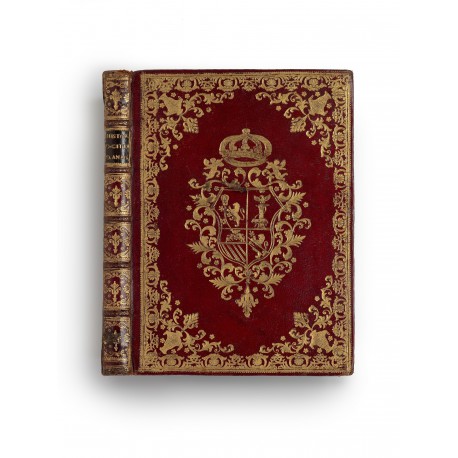 View larger
View larger
Istoria della città e S. Basilica Cattedrale d’Anagni, in cui si rapportano personaggi insigni, cose più ragguardevoli della Diocesi, e molti avvenimenti d’Italia
- Subjects
- Bookbindings, Armorial
- Italy - Description and travel - Early works to 1800
- Mosaics, Medieval
- Authors/Creators
- De Magistris, Alessandro, 1682-1762
- Printers/Publishers
- Silvestri, Marcello (Stamperia di S. Michele a Ripa Grande), active 1747?-1760?
- Owners
- Sforza Cesarini, Filippo, principe di Santa Fiora, Genzano e Valmontone, 1727-1764
De Magistris, Alessandro
Istoria della città e S. Basilica Cattedrale d’Anagni, in cui si rapportano personaggi insigni, cose più ragguardevoli della Diocesi, e molti avvenimenti d’Italia.
Rome, Marcello Silvestri (printed ‘Nella Stamperia di S. Michele Per Ottavio Puccinelli’), 1749
quarto (235 × 175 mm), (104) ff. signed A4 A–Z4 Aa–Bb4 and paginated (8) 1–199 (1), title-page printed in red and black, two woodcuts printed with the text (‘Parte Anteriore della Sagra Tavola Anagnina’ and ‘Parte Posteriore della medesima’, both on folio M4 recto), woodcut head-pieces and initials from several alphabets; plus a folding woodcut view captioned ‘Anagni’ (block circa 160 × 250 mm, sheet 235 × 305 mm).
Minor insect damage on covers of binding, insect damage also to margin of title and following leaf (expertly repaired), one gathering lightly spotted, otherwise a well-preserved copy.
provenance duke Filippo i Sforza Cesarini Savelli (1727–1764), his insignia on binding — [Arturo Dazza (d. 2010)] — his sale by Bloomsbury Auctions, Rome, 6 December 2006, lot 120
bound in contemporary red morocco in an anonymous Roman shop, covers decorated by frames of flower, foliage, and shell ornaments, with a flower vase in the angles; in centres the elaborate gilt insignia of the dedicatee, Filippo i Sforza Cesarini Savelli; back divided by raised bands into six compartments and decorated by other flower and foliage tools, black lettering-piece Histor | D. Citta | D. Anag.; page edges gilded; gilt embossed endpapers.
Only edition of an account of the Cathedral of Santa Maria in Anagni (constructed 1071–1105, altered in 1350), in the hills east-southeast of Rome, famous for its connections with the papacy (Innocent iii, Gregory ix, Alexander iv, and Boniface viii were born here, and the English pope Adrian iv died here). Its works of art, particularly the 13th-century frescoes in the crypt of S. Magno, and mosaic pavement (laid 1231) by Cosma di Iacopo of the Cosmatus family, have generated a large literature, in which the present book is routinely cited.
The publisher, Marcello Silvestri, dedicated the book to Filippo Sforza Cesarini Savelli (1727–1764), and ordered this copy to be bound for the dedicatee in red morocco (it has no marks of ownership to prove that it was ever delivered).
The author, apostolic protonotary and one of twenty-four canons of the Cathedral, commences with a topographical description of the town and its history as a holy city and spiritual centre, from Henrican-Roman into Christian times.1 He next describes the Cathedral ‘Dello Stato antico’ and ‘Dello Stato moderno’, listing its ecclesiastical relics, and relics preserved in other churches in the diocese (one of these – believed to be made of wood from the Cross, and kept in the sacristy in the Romanesque church of S. Andrea Apostolo – is illustrated by two woodcuts). At the end are about fifty pages of documents transcribed from the Cathedral archives.
The book is comparatively rare: six copies are located in the Italian census (iccu), and elsewhere sixteen can be traced:
● Avignon, Bibliothèque Municipale ● Berlin, Staatsbibliothek zu Berlin ● Champaign-Urbana, University of Illinois ● Cambridge, Cambridge University Library ● Cambridge, ma, Harvard University ● Göttingen, Niedersächsische Staats- und Universitätsbibliothek ● Jena, Thüringer Universitäts- und Landesbibliothek ● London, British Library, two copies ● London, National Art Library ● Munich, Bayerische Staatsbibliothek ● Paris, Bibliothèque nationale, two copies ● Princeton, Princeton University ● Rouen, Bibliothèque Municipale ● Stuttgart, Württembergische Landesbibliothek
A facsimile reprint was published at Bologna by Forni in 1987.
references Pietro Riccardi, Biblioteca matematica italiana (Modena 1870), i, col.31; Deutsches Archäologisches Institut, Katalog der Bibliotheca Platneriana (Rome 1886), p.38
1. Salvatore Sibilia, ‘Il canonico Alessandro De Magistris ed alcuni agiografi del Settecento anagnino’ in Bollettino dell’Istituto di Storia e di Arte del Lazio Meridionale 1 (1963), pp.95–126 (title-page and woodcuts reproduced).



